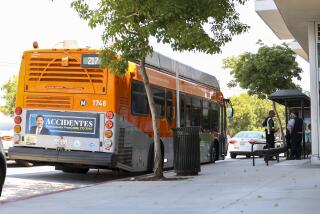Funding OKd to Restore Pasadena Bridge
PASADENA — A decaying bridge across the Arroyo Seco that city officials and preservationists have fought for a decade to save has been assured of a long life with a $12.7-million federal grant.
The Colorado Street Bridge--named in 1913 before Pasadena’s main business street became Colorado Boulevard--will be rebuilt almost from the ground up. It will even have its original ornamentation, thanks to the Federal Highway Administration grant that will cover 80% of the restoration costs.
“We’ll all sleep better now,” said City Engineer Dave Barnhart, who predicted that the restoration will add another 75 years to the bridge’s life. He called saving it “something this community has pulled together and worked for many years.”
Sen. Pete Wilson (R-Calif.) announced the grant Tuesday at an informal gathering of city and state officials and a few preservationists at the bridge’s eastern terminus. Mayor William Thomson said more restoration money, for a total of $16 million, will come from city and state funds.
From 1913 to the early 1970s, the Colorado Street Bridge was the only span across the Arroyo Seco. After a parallel freeway route was built, the need for the old bridge and the justification for restoring it were questioned. Nonetheless, citizens groups began fighting state highway attempts to demolish it.
The bridge is listed on the National Register of Historic Places and the Register of Civil Engineering Landmarks and has become famous for its graceful arches, which many artists have painted.
Anticipating the grant, the city has begun planning for the restoration, expected to begin early in 1990 and end late in 1991.
Blueprints of the original design were retrieved from city archives, and Alan Charmatz, principal engineer for the city, said they will be followed exactly, except to make the bridge 2 feet wider. It will be refitted with elaborate light brackets, each having four globes, and with quaint seating alcoves and urn-shaped supports for a balustrade.
Major Rebuilding
The bridge will be stripped down to its 11 arches, and its entire superstructure will be rebuilt. Underground supports will be strengthened to bear the weight of heavy trucks, Charmatz said.
“It has held up for 75 years, and that’s a long time for a bridge,” Charmatz said. “What we’re doing will add another 75 years.”
Cracks in the surface of the concrete have allowed water to seep in and rust reinforcing steel, Barnhart said. Hunks of concrete have fallen into the arroyo. However, a study last year showed that the Oct. 1, 1987, earthquake did no structural damage, and the bridge still carries about 5,000 vehicles daily.
“It’s a matter of slow deterioration,” Barnhart said. “Unless we take action, it will collapse of its own weight.”
Claire Bogaard, executive director of Pasadena Heritage, said neighborhood groups first rallied to save the bridge in 1977 when the state proposed demolishing it. A study at that time determined that the bridge was structurally sound enough to save if action was taken soon. The city then began more than a decade of efforts to obtain government funding.
“The majority of my professional career has been devoted to getting this bridge rehabilitated,” said Arthur Krieger, former director of public works and transportation for the city.
More to Read
Sign up for Essential California
The most important California stories and recommendations in your inbox every morning.
You may occasionally receive promotional content from the Los Angeles Times.










